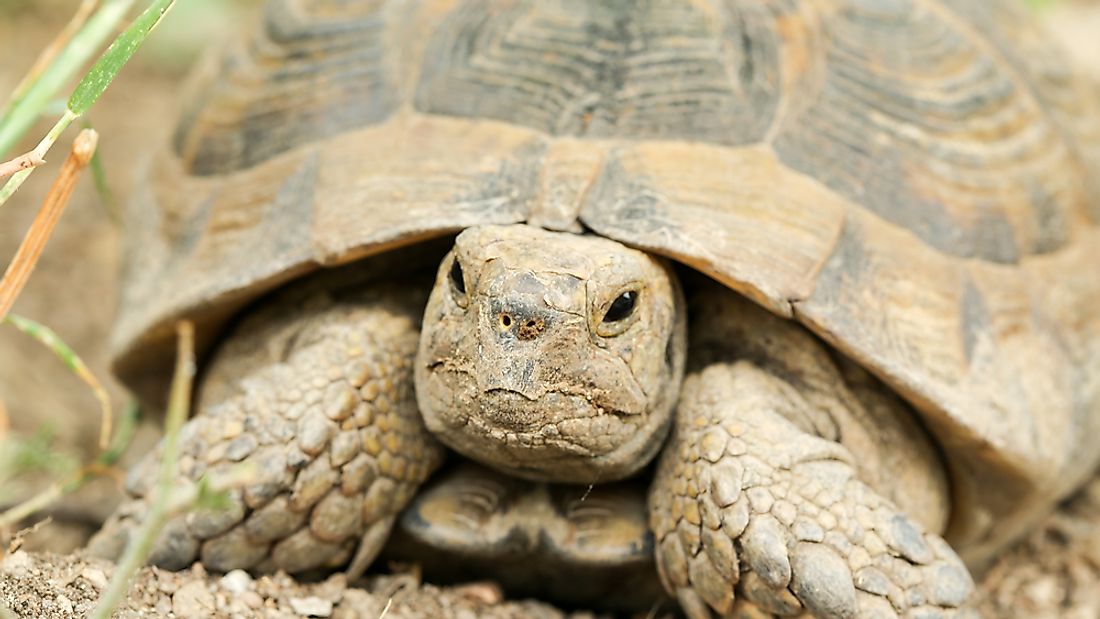Native Reptiles Of Spain

Spain is a country with extremely rich biodiversity. In fact, it is one of the 25 biodiversity hotspots in the world. The rich biodiversity in Spain is as a result of the country’s geographic location, geological diversity, and the various climatic conditions. Spain has four biogeographical regions, out of the nine in existence in the European Union. However, despite this richness, Spain has the most fragile biodiversity in Europe with a high number of endangered species. Spain has over 45 species of both land and freshwater reptiles as part of its biodiversity.
Native Reptiles Of Spain
Spur-Thighed Tortoise (Testudo graeca)
Spur-Thighed Tortoise is a species of Mediterranean tortoise. It is a long-lived tortoise which can achieve a lifespan of up to 125 to 200 years. It is found mainly in the Southern Europe, North Africa, and southwestern parts of Asia. Spur-Thighed Tortoise has large symmetrical markings on the head and widely stretched spinal plates. The front legs have large scales while the shell is somehow rectangular.
Iberian worm lizard (Blanus cinereus)
Iberian worm lizard is a reptile species in the family Balanidae. It is locally known as culebrilla ciega in Spanish meaning “blind snake.” It is found widely in the Mediterranean habitat. It is an opportunist feeder with its diet consisting of large insects. Iberian worm lizard is limbless with a ringed body covered with scales. It has small, underdeveloped eyes. Its head is small and blunt adapted for digging. An adult Iberian worm lizard measures up to 300 mm and is sometimes mistaken for small snakes. It can distinguish between live prey and non- live prey by the chemicals produced by the individual.
Spanish Pond Turtle (Mauremys leprosa)
Spanish Pond Turtle is a turtle species. It is distributed in the larger parts of Spain, Portugal, and parts of North Africa. Spanish Pond Turtle can grow to 20 cm long and has a high degree of sexual dimorphism. It is a carnivore and hunts animals such as frogs, snails and insects although it might feed on vegetation. Spanish Pond Turtle is currently is facing the danger of extinction in Spain due to the degradation of its habitat, pollution, and competition from other species.
Iberian Cross Adder (Vipera seoanei)
Iberian Cross Adder is a venomous snake species found in the northern regions of Spain/ an adult Iberian Cross Adder may grow to a length of 75 cm from head to tail. The species has four main color patterns; brown zigzag pattern down the back, uniform brown with no pattern, fragmented zigzag pattern, and a twin-strip pattern. Iberian Cross Adder is classified as least concern by the IUCN due to its relatively wide distribution and population. However, it is a protected species in Spain.
Conservation Efforts
Most reptiles of Spain are listed as protected as a conservation measure to preserve the fragile biodiversity of Spain. It is illegal to trade in some of the reptiles including the tortoise species. Illegal trade in such species attracts fines and penalty under the Environmental Protection Act in Spain. The major threats to reptiles in Spain include the destruction of habitat, pollution, and competition from other species.
Native Reptiles Of Spain
| Native Reptiles of Spain | Scientific Name |
|---|---|
| Spur-Thighed Tortoise | Testudo graeca |
| Iberian Worm Lizard | Blanus cinereus |
| Spanish Pond Turtle | Mauremys leprosa |
| Iberian Cross Adder | Vipera seoanei |
| Mediterranean House Gecko | Hemidactylus turcicus |
| Bedriaga's Skink | Chalcides bedriagai |
| Slow Worm | Anguis fragilis |
| Spanish Algyroides | Algyroides marchi |
| Ladder Snake | Rhinechis scalaris |
| Green Sea Turtle | Chelonia mydas |







